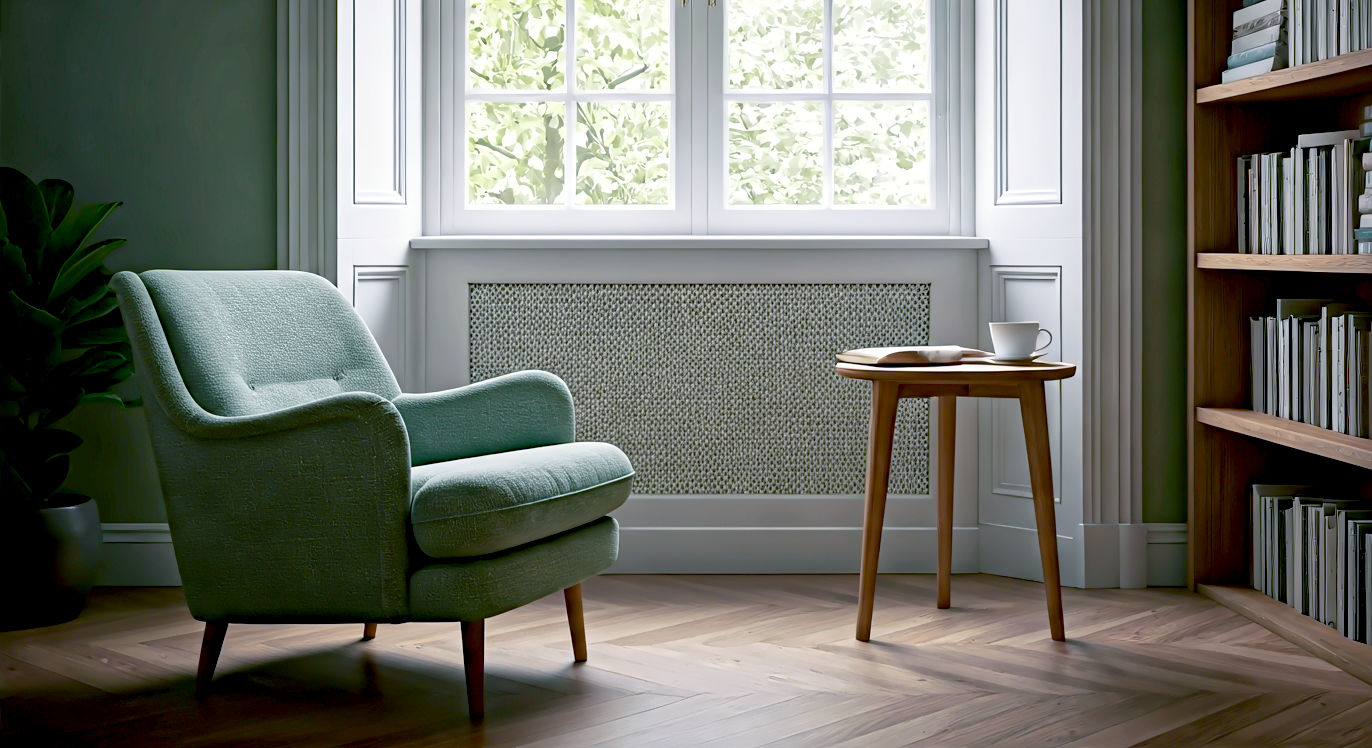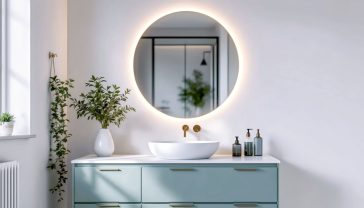The Unseen Architect: How Your Home Is Quietly Shaping Your Mind
Your home is more than just a shelter; it’s a powerful force shaping your mental health. Explore the science behind how our living spaces affect our minds.

This post may contain affiliate links. If you make a purchase through these links, we may earn a commission at no additional cost to you.
We’ve all felt it. That deep, contented sigh when you finally walk through your front door after a long day. The simple comfort of your favourite armchair, the familiar view from the kitchen window, or the gentle scent of home that you can’t quite describe. It’s a feeling that goes far beyond just having a roof over your head. It’s the feeling of being home.
But have you ever stopped to wonder why it feels that way? What is it about these bricks and mortar, these collections of furniture and memories, that holds such a powerful sway over our minds? The truth is, our homes are not just passive shelters. They are active participants in our lives, constantly shaping our thoughts, feelings, and behaviours in ways we rarely notice.
This is the fascinating field of environmental psychology, and it reveals a profound connection between our living spaces and our mental health. From the colour of your walls to the clutter on your shelves, every detail of your home is sending subtle messages to your brain. It can either be a sanctuary that nurtures your well-being or a source of low-level stress that quietly chips away at it.
In Britain, where we spend so much of our time indoors (thanks, weather!), understanding this connection is more important than ever. Our homes have become our offices, our gyms, our cinemas, and our pubs. They are the backdrop to our lives. By learning how to design them with our minds in mind, we can unlock a powerful tool for improving our happiness, productivity, and overall mental resilience. So, let’s unlock the door and explore the hidden psychology of home.
What Is a ‘Home’ Anyway? The Psychology of Our Personal Sanctuaries
At its most basic, a house is just a building. It provides shelter from the rain and a place to sleep. A home, however, is something much more. It’s a place woven with identity, memory, and emotion. Psychologists believe that our homes become an extension of ourselves—a concept known as ‘place identity’.
Think about it. The things you choose to display—the family photos on the mantelpiece, the dog-eared books on the shelf, the quirky mug from a seaside holiday—are all reflections of who you are, what you value, and where you’ve been. They tell your story. This is why it can feel so violating when our homes are burgled or damaged; it’s not just about the loss of possessions, but a disruption of our very sense of self.
The Power of Control and a ‘Psychological Anchor’
One of the most crucial psychological functions of a home is that it provides a sense of control. In a world that often feels chaotic and unpredictable, your home is your domain. You decide who comes in, what goes on the walls, and whether it’s acceptable to eat biscuits on the sofa. This feeling of agency is fundamental to our mental well-being. It’s our safe harbour, a place where we can retreat, recharge, and be our most authentic selves without fear of judgement.
During the COVID-19 lockdowns, this became clearer than ever. Our homes had to become our entire world, and those who felt a strong sense of control and comfort within their four walls often coped better with the immense stress of the pandemic. Their home was a psychological anchor in a stormy sea.
Nostalgia and the Scent of Home
Our homes are also powerful vessels of memory and nostalgia. The smell of a particular polish might transport you back to your grandmother’s house, or the sound of a creaky floorboard might remind you of your childhood home. These sensory triggers are deeply linked to the emotional centres of our brains.
This is why creating new, positive memories in your space is so important. Hosting a dinner for friends, celebrating a birthday, or simply enjoying a quiet Sunday morning—these experiences infuse your home with a sense of warmth and history, strengthening its role as a place of comfort and belonging.
Let There Be Light: Why Natural Light Is a Mental Health Superfood
If there’s one ingredient that can instantly transform the feel of a home, it’s natural light. It’s not just about being able to see what you’re doing; light has a profound and direct impact on our biology and mood.
Our bodies are finely tuned to the natural cycle of day and night, a rhythm known as the circadian rhythm. This internal clock governs everything from our sleep-wake cycle to our hormone production and energy levels. Bright, natural light during the day signals to our brains that it’s time to be awake, alert, and active. It boosts the production of serotonin, a neurotransmitter often dubbed the ‘feel-good’ chemical, which helps to elevate our mood and promote feelings of calm and focus.
The British Battle for Light
In the UK, with our notoriously grey skies and short winter days, getting enough natural light can be a real challenge. It’s no coincidence that many people experience a dip in their mood and energy during the winter months, a condition known as Seasonal Affective Disorder (SAD).
When we’re deprived of natural light, our brains can produce more melatonin, the hormone that makes us feel sleepy, leading to lethargy and low spirits. This makes maximising the light in our homes incredibly important.
Practical Tips for a Brighter Home:
- Clean Your Windows: It sounds simple, but you’d be surprised how much light is blocked by a layer of grime. Give your windows a good clean, inside and out.
- Use Mirrors Strategically: A large mirror placed opposite a window can work wonders, bouncing light around the room and creating an illusion of space.
- Choose Lighter Colours: Dark colours absorb light, while pale shades of white, cream, and pastels reflect it. Consider a lighter paint colour, especially in north-facing rooms that receive less direct sun.
- Rethink Your Curtains: Heavy, dark curtains can swallow light. Opt for lightweight fabrics like linen or voile, or consider installing blinds that can be fully retracted during the day.
- Trim the Hedges: If overgrown trees or bushes are casting a shadow over your windows, give them a prune to let the light flood in.
The Colour Conundrum: How Hues Shape Your Mood
The colours we surround ourselves with have a surprising ability to influence our emotions. This isn’t just a matter of personal taste; it’s rooted in psychology, culture, and our evolutionary past. While our individual responses to colour can vary, some general principles can help you create a home that supports your mental state.
The Psychology Behind the Paint Tin
- Warm Colours (Reds, Oranges, Yellows): These colours are associated with energy, warmth, and optimism. They can be great for social spaces like dining rooms or kitchens, as they tend to stimulate conversation and appetite. However, they can be overstimulating in large doses. A bright red bedroom, for instance, might not be the most restful place to sleep. Think of them as the extroverts of the colour world—best in social situations.
- Cool Colours (Blues, Greens, Purples): These hues are linked to calmness, serenity, and nature. They are known to have a soothing effect on the mind, making them perfect for bedrooms, bathrooms, and living rooms where you want to relax and unwind. Studies have even shown that the colour blue can help lower blood pressure and heart rate.
- Neutral Colours (Greys, Whites, Beiges): Neutrals provide a sense of calm, simplicity, and sophistication. They are wonderfully versatile and can create a peaceful backdrop that allows your furniture and art to stand out. However, a space that is too neutral can sometimes feel a bit sterile or uninspiring. It’s often best to use them as a canvas and add pops of colour through accessories.
Finding Your Perfect Palette
There’s no one-size-fits-all answer here. The key is to think about how you want to feel in a particular room. Do you want your home office to feel energising and creative? Perhaps a splash of yellow or a vibrant green is the answer. Do you want your living room to be a tranquil haven for binge-watching your favourite BBC drama? A soft blue or a gentle grey might be just the ticket.
Don’t be afraid to experiment. Tester pots are your best friend. Paint a small patch on a wall and live with it for a few days. See how it looks in different lights and how it makes you feel before you commit.
Order in the House: The Calming Effect of a Clutter-Free Space
Take a quick look around the room you’re in. What do you see? Piles of unopened post? A ‘floordrobe’ of clothes that never quite made it back to the wardrobe? A collection of mugs on your desk? Be honest. How does it make you feel?
For most of us, clutter is a significant source of unspoken stress. When our eyes are constantly scanning over a mess, our brains get overloaded with stimuli. This makes it difficult to relax, focus, and process information. In essence, physical clutter creates mental clutter.
A 2010 study from Princeton University found that a cluttered environment competes for your attention, resulting in decreased performance and increased stress. The visual chaos sends a signal to our brains that our work is never done, creating a persistent, low-grade sense of anxiety.
Why We Cling to Clutter
Getting rid of clutter is easier said than done. We often attach emotions to our possessions. That concert ticket from ten years ago isn’t just a piece of paper; it’s a memory. The jumper you never wear was a gift from your mum. This emotional attachment can make decluttering feel like a painful process of letting go.
Furthermore, decision fatigue is real. The sheer number of choices involved in tidying up—what to keep, what to throw away, what to donate, where to store things—can be mentally exhausting, causing us to simply give up and leave the pile for another day.
The Joy of an Organised Home
The benefits of a tidy home go far beyond aesthetics. When your space is organised, you know where everything is, which saves time and reduces frustration. More importantly, it creates a sense of calm and control. A clear space allows for a clear mind.
Many people find the act of cleaning and organising itself to be therapeutic. It’s a form of mindfulness—a simple, repetitive task that allows you to focus on the present moment and see a tangible result for your efforts.
Simple Steps to a Tidier Mind:
- Start Small: Don’t try to tackle the whole house at once. Pick one small area, like a single drawer or one shelf, and start there. The sense of accomplishment will motivate you to continue.
- The ‘Four-Box’ Method: Get four boxes and label them: Keep, Donate, Bin, and Relocate. Go through your items one by one and place them in the appropriate box. Be ruthless!
- One In, One Out: To prevent clutter from building up again, adopt a simple rule. Every time you bring something new into the house, something similar has to go.
- Everything Needs a Home: The secret to staying organised is ensuring that every single item you own has a designated storage spot. If it doesn’t have a home, it becomes clutter.
The Great Outdoors, Indoors: Biophilia and the Power of Nature
Humans have an innate need to connect with nature. For thousands of years, we lived in close harmony with the natural world. It’s only in the last few centuries that we’ve started spending the majority of our lives inside buildings. This disconnection from nature can have a negative impact on our mental health.
The concept of biophilia, popularised by the biologist E.O. Wilson, suggests that we have a biological urge to affiliate with other forms of life. Biophilic design is the practice of bringing elements of nature into our indoor spaces to help satisfy this urge.
How Nature Nurtures the Mind
The positive effects of nature on our well-being are well-documented. Exposure to natural environments can reduce stress, lower blood pressure, improve focus, and boost our mood. Even just looking at a picture of a landscape can have a calming effect.
By incorporating natural elements into our homes, we can tap into these benefits, creating a space that feels restorative and life-affirming.
Ways to Bring the Outside In:
- Houseplants are Your Friends: A few potted plants can do wonders for a room. Not only do they look beautiful, but they also help to purify the air. Studies have shown that simply having plants in a room can reduce stress and improve concentration. If you’re not green-fingered, start with something low-maintenance like a snake plant or a spider plant.
- Use Natural Materials: Incorporate materials like wood, stone, bamboo, and rattan into your decor. A wooden dining table, a slate hearth, or a woollen throw can add a touch of natural warmth and texture to your home.
- Let the View In: If you’re lucky enough to have a view of a garden, a park, or even just a single tree, make it a focal point of the room. Arrange your furniture to take advantage of the view and keep the window uncluttered.
- Natural Scents and Sounds: Use essential oil diffusers with scents like lavender, pine, or bergamot to evoke the smells of nature. You can also play recordings of natural sounds, like birdsong or rainfall, to create a tranquil atmosphere.
Designing for Connection: The Social Heart of the Home
While our homes need to be personal sanctuaries, they also play a vital role in our social lives. They are the places where we connect with family, entertain friends, and build relationships. The layout and design of your home can either encourage or hinder these social connections.
The Rise of Open-Plan Living
The shift towards open-plan living in recent decades is a perfect example of this. By knocking down the walls between the kitchen, living room, and dining room, we created spaces that were more conducive to modern family life. It allows parents to cook dinner while keeping an eye on the kids, or for hosts to chat with their guests while preparing food.
However, open-plan living isn’t for everyone. The lack of privacy can be a source of conflict, especially as families grow and needs change. The key is to find a balance that works for your household.
Creating Spaces for Togetherness
Think about how you can create pockets of space that encourage social interaction. A comfortable seating area where people can gather and chat, a dining table that’s big enough for the whole family, or even a couple of chairs on a balcony can all become hubs of connection.
It’s also important to consider the flow of a room. Is there a clear path for people to move around without bumping into furniture? Is the seating arranged in a way that facilitates conversation, or is it all pointing towards the television? Small tweaks can make a big difference to how sociable a space feels.
The Future of Home: Spaces That Adapt to Us
The way we live is changing, and our homes are changing with us. The rise of remote working, the need for multigenerational living, and a growing awareness of sustainability are all shaping the future of home design.
We are moving towards homes that are more flexible and adaptable. A dining table might need to double as a desk during the day. A spare room might need to function as a home gym, a guest room, and a quiet space for hobbies. Smart home technology will also play a bigger role, allowing us to personalise our environments—from lighting to temperature—with the touch of a button, creating spaces that are perfectly tuned to our needs and moods.
Ultimately, the psychology of home is about creating a conscious and intentional relationship with the spaces we inhabit. It’s about recognising that our homes are not just containers for our lives, but powerful tools that can help us live better.
By understanding the subtle ways in which light, colour, layout, and nature affect our minds, we can start to make small, meaningful changes. We can transform our houses from mere structures into true homes—sanctuaries that support our mental health, reflect our identities, and help us to thrive. So take another look around. Your home is talking to you. What is it saying?
Further Reading
For those interested in exploring this topic further, here are some highly respected resources:
- MIND: The UK’s leading mental health charity offers extensive resources on well-being and how environment can play a role. mind.org.uk
- The Journal of Environmental Psychology: A leading academic journal for cutting-edge research on the relationship between people and their physical settings. sciencedirect.com/journal/journal-of-environmental-psychology
- Happy by Design: A Guide to Architecture and Mental Wellbeing by Ben Channon: An excellent book by an architect exploring how buildings can be designed to support mental health.
- The Design Council: A UK charity that champions the power of design to improve lives, with many articles on inclusive and health-focused design. designcouncil.org.uk






